Rotaviruses are important enteric pathogens that affect newborns of several animal species. In swine, they can cause gastroenteritis in piglets.
Aetiology
Rotaviruses are RNA viruses, characterized by an icosahedral capsid structure which lack of external envelop. It has been identified, at least, 7 different serogroups (A to G). Rotaviruses belonging to serogroups A, B and C infect humans and other animal species, including swine. Serogroup E rotaviruses have been detected only in swine while those of serogroups D, F and G have been identified in birds. In addition, each serogroup includes several serotypes, with different structural proteins in the outer capsid.
Cross protection among rotavirus infections of different serogroups has not been detected. However, partial protection among different serotypes within a serogroup is reported.
The absence of a lipid envelope and the presence of a double protein capsid determine rotavirus resistance to a wide range of pH, temperatures and many common disinfectants. Therefore, they are extremely resistant in the environment, retaining their capacity to infect for months.
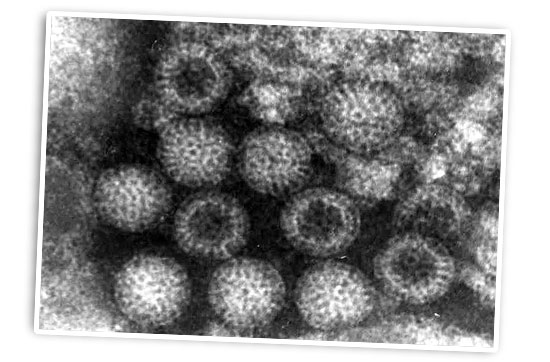
Epidemiology
Porcine rotaviruses, particularly serogroup A, are widely distributed all over the world. Studies performed in different countries have shown prevalence rates about 100% using porcine sera, indicating that infection is presented in practically all farms.
Disease transmission is horizontal, by the faecal-oral route. Pigs become infected with rotavirus from the faeces of other pigs. Their environmental resistance and the low dose necessary for becoming infected make difficult to control the transmission. Once the pigs have been infected, they shed rotavirus in faeces for 1 to 2 weeks.
Although rotavirus infection can affect pigs of any age, it is most often detected in piglets less than 6 weeks old. However, the incidence in the first week of life is generally low, increasing progressively with the age. This fact is related to the decrease in the antibody intake through colostrum and milk. The highest proportion of infected animals is detected between 3 to 5 week-old pigs. After that, infection is less frequently detected.
The main source of infection seems to be older pigs, particularly sows. A significant proportion of immunized sows are able to eliminate rotaviruses between day 5 before delivering and up to 2 weeks after, without any clinical signs.

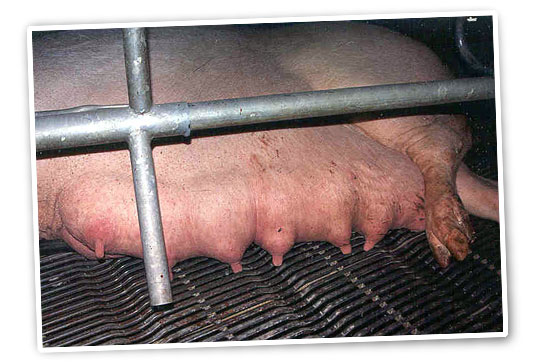
Classically, it is considered that porcine rotaviruses only affect this species. Nevertheless, some authors have suggested occasional transmission of rotavirus between different species. Bovine rotaviruses have been identified in pigs with diarrhoea, while rotaviruses of porcine origin have been isolated in outbreaks of gastroenteritis in horses and humans.
Pathogenesis
Rotaviruses replicate exclusively in the cytoplasm of mature enterocytes covering the tips of the small intestine villi. These cells have enterokinase, an enzyme necessary for activating trypsine, which activates rotaviruses.
Virus replications induce degeneration and lysis of the enterocytes and, consequently, atrophy of the villi. The degree and extent of the atrophy is lower than that caused by other viral enteric infections in swine, such as transmissible gastroenteritis or porcine epidemic diarrhoea.
In a healthy piglet, the proportion between the length of the intestinal villi and the depth of the crypts is 7 to 1. Rotavirus infection changes that ratio to 5 to 1, while in animals suffering from transmissible gastroenteritis, the most serious viral infection; it can be as low as 1 to 1.
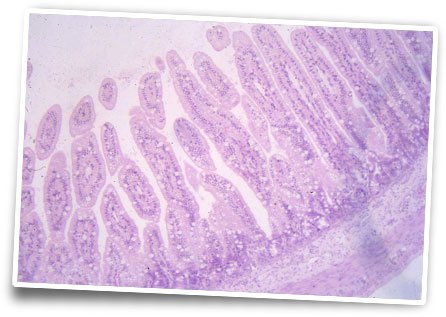
The atrophy of the villi is more severe and has a deeper effect on the surface of the intestinal epithelium of young piglets. Serogroup A and C rotaviruses are associated with a lower pathogenicity while serogruop B is related with a greater pathogenic capacity. The recovery of intestinal epithelial lesions starts shortly after infection and intestinal villi are restored.
The main mechanism that allows rotaviruses to cause diarrhoea is a low feed absorption, consequence of the destruction of mature enterocytes. It also causes a decrease in enzymatic activity. Undigested food increases osmotic pressure in the intestinal lumen, leading to water retention which results in diarrhoea. The proliferation of immature enterocytes on the crypts, which replace the mature enterocytes that have been destroyed, contributes to diarrhoea by means of their secreting activity.
Recent studies have suggested the involvement of the local inflammatory response in the pathogeny of diarrhoea caused by rotavirus.
Clinical signs and lesions
Under proper pig farming conditions, most of rotavirus infections are subclinical or show few clinical signs, particularly in suckling piglets. In most of the farms, sows have high antibodies titers against rotavirus, indicating that the infection affects all farms, being enzootic. These antibodies are transferred to the piglets by colostrum and milk.
Diarrhoea appears when the piglets ingest a high dose of rotaviruses, being able to exceed the passive immunity, or when there are failures during milking that prevent the piglets from receiving a sufficient amount of antibodies. These failures happen more frequently in primiparous sows or in sows suffering from agalactia or with reduced milk production.
Therefore, the clinical course of porcine rotavirus infection in field conditions will be determined by the immunity that the piglets receive from their mothers, the pressure of infection in the farrowing pens (cleaning and disinfection of these facilities), as well as other factors that affect somehow the proper housing and feeding of the piglets.
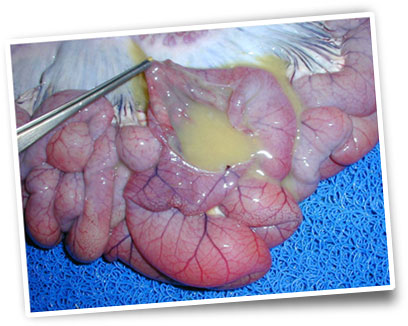
The clinical profile of suckling piglets is characterized by loose or liquid stools, whitish or yellow in colour. If no other complications set in, diarrhoea ceases within 2 or 3 days. Although morbidity is usually moderate (<20%), mortality is lower, particularly in those farms with a good handling and housing facilities. Otherwise, the clinical profile, morbidity and mortality rates can increase, being usually associated to other diseases.
After weaning, most of rotavirus infections are asymptomatic or associated with light diarrhoea of short duration. Rotavirus infection in weaning piglets might aggravate the course of concurrent infections, such as E. coli.
The lesions associated to rotavirus infections in piglets are restricted to the small intestine, particularly to the jejunum and the ileum. In young piglets, thinning of intestinal walls can be noticed in the small intestine. Microscopically it can be observed the degree of shortening of the villi and hypertrophy of the Liebërkuhn crypts.
Diagnosis
The clinical signs and lesions associated with rotavirus infections in piglets are not specific. Therefore, laboratory diagnosis is necessary to confirm the aetiological agent.
Direct detection of rotaviruses in pig faeces can be done with different techniques, such as ELISA, a nucleoprotein-latex agglutination test or RT-PCR.
However, it is important to keep in mind that subclinical course of rotavirus infections is not unusual. In addition, the detection of rotaviruses in the faeces of a piglet does not necessarily imply that rotaviruses are the aetiological agent of the diarrhoea or the most important etiologic agent presented in an outbreak.
It is necessary to discard the presence of other enteric bacterial or parasitic agents which might be involved such as E. coli, Clostridium or Isospora suis. In addition, an assessment of the farming conditions and the age of the affected animals might be helpful in order to establish a definitive diagnostic.
Treatment and control
As happen with other porcine viral infections, there is not aetiological treatment for diarrhoea due to rotavirus.
The use of drinking water with solutions containing electrolytes, glucose and glycine restrict mortality. In addition, the use of isotonic intraperitoneal injection can be useful, particularly in farms with a low number of affected litters.
Special attention to proper environmental conditions and pig handling techniques should be paid, as well as to hygiene and problems arisen during lactation. These measures are essential for control of diarrhoea due to rotavirus.
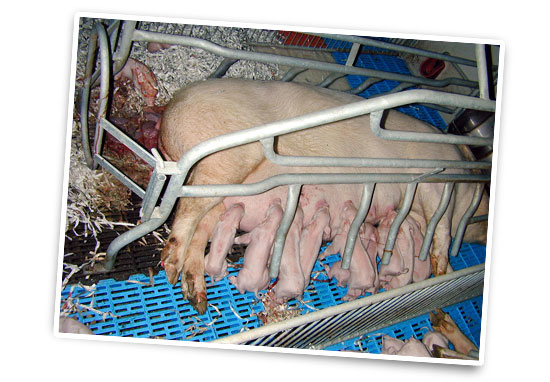
As we have indicated previously, the rotaviruses are presented on almost every pig unit. Their extremely high environmental resistance makes complete elimination of rotaviruses from farms a practically impossible task. Control measures should be directed towards decreasing the pressure of infection in the farrowing pens and strengthening maternal immunity transferred from sows to piglets.
In order to diminish the pressure of infection, farrowing pens and post-weaning pens should be designed to help cleaning and minimize contact with faeces. The “all in-all out” swine production system and the application of suitable cleaning and disinfection protocols between batches are useful.
In addition, it would be highly desirable to boost immunity in sows periodically, increasing antibody titers and, therefore, the level of immunoglobulins secreted in milk during lactation.
This approach is particularly recommended for primiparous sows, which usually have a low level of immunity against rotavirus. It can be achieved by vaccination during gestation, vaccines are already available in some countries, or, more easily, by exposing sows to faeces of suckling and recently weaned piglets.




